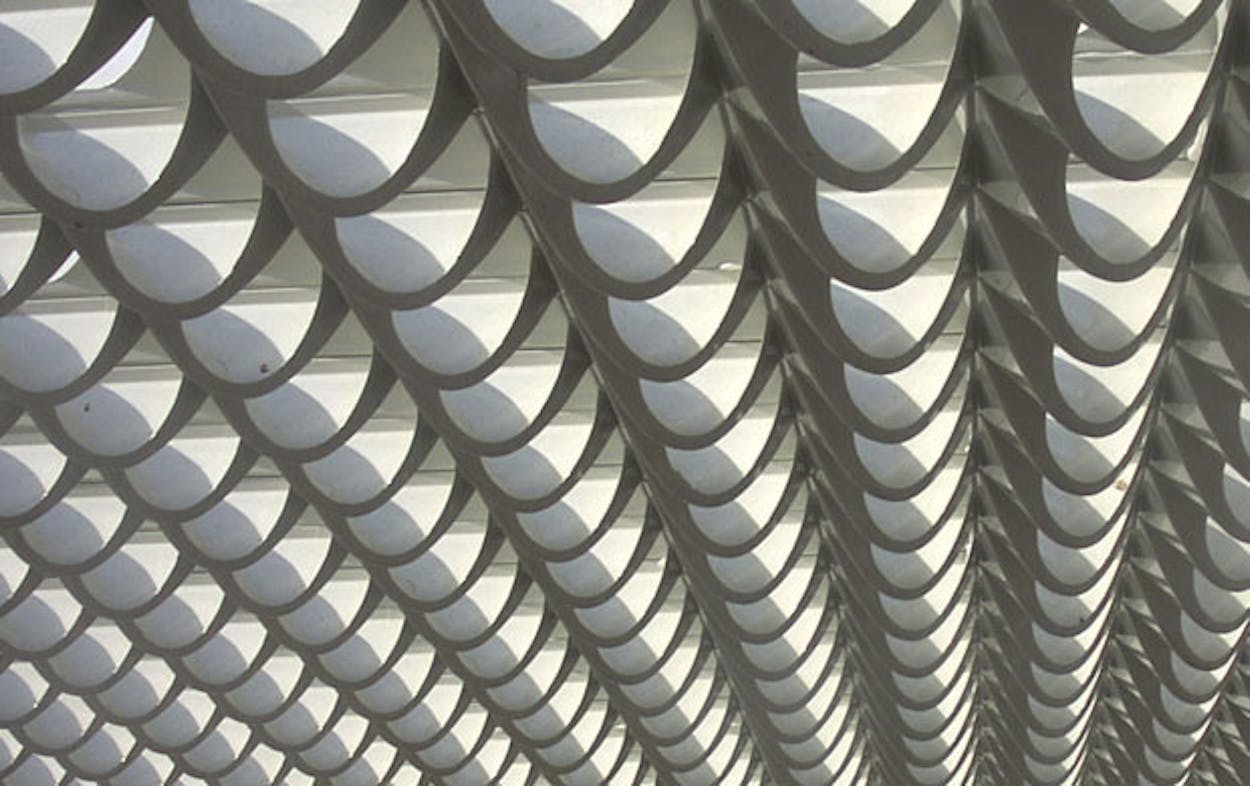The owners of Museum Tower took out a full-page ad in the Dallas Morning News Friday to apologize (sort of) that their new building is so shiny.
Since the glass panels were installed on 42-story tower, it has been sending uninvited rays of sunshine through the screen roof of the Nasher Sculpture Center, which was designed by Pritzker Prize-winning starchitect Renzo Piano. (And this isn’t even the first insult the new tower has visited on the museum and sculpture garden: it already forced the closure of James Turrell’s Tending (Blue) when it crept into the frame of the “skyspace” installation.)
The Nasher features “a barrel-vaulted glass ceiling” (pictured above) that is “suspended above the galleries, atop narrow steel ribs and supported by thin, stainless steel rods,” according to the museum’s website. Piano told the New York Times in a May story that natural light informed the design of his building. The galleries were “laid out in anticipation of the sun’s daily arc from southeast to southwest.” But now, the reflection from the Museum Tower sends sunshine into the museum from the north, scattering the light in ways that Piano did not intend. “By doing this, they destroy completely the logic of the building,” Mr. Piano told the Times.
The letter, which ran on the back of the business section and was addressed to “our future residents, neighbors, art lovers and citizens of Dallas,” strikes an “I’m sorry I’m not sorry” tone:
Since construction began, much has been reported about sunlight reflection from Museum Tower’s glass surface. Prior to construction, Museum Tower’s design plans were open for comprehensive public review and approved by the City of Dallas. Museum Tower is in compliance with every city code. However, it’s not uncommon for bold projects like Museum Tower to encounter an unexpected issue or two, and they are invariably solved.
Our number one priority is finding the best solution to the reflection issue. Over the last year, Museum Tower’s owner, the Dallas Police and Fire Pension System, engaged the most prominent optical experts in North America to study this challenge. A team of architects, engineers, and material and construction experts evaluated more than 20 ideas. Today, the most promising potential solutions are undergoing exhaustive testing with the highest standards of science and technology being applied.
Before launching into that half-hearted mea culpa, the owners of Museum Tower take a moment to pat themselves on the back, calling their creation “one of the most environmentally responsible and elegant residential towers in the world.” (Later in the letter, a sentence declares that the building “is already internationally recognized as a work of art unto itself and a graceful example of environmentally responsible construction.”)
At Frontburner, D Magazine editor Tim Rogers offers this alternative, more honest text: “A team of architects, engineers, and material and construction experts evaluated more than 20 ideas. Today, we believe the best option is for the Nasher Sculpture Center to change its roof. We’ve told them that. They won’t listen.”
And at Unfair Park, the Dallas Observer‘s Anna Merlan offered a glimpse into the thought process of George Tomasovic, who chairs the Dallas Police and Fire Pension System’s board of trustees.
“A simple solution would be to shade or make a modest, and from their visitors’ experience, an almost invisible change to the design of the roof skylights of the Nasher,” he wrote in a newsletter last month. “For some reason, that seems to be out of the question. It has been done in other cities with [Renzo] Piano designed roofs, because of similar reflectivity issues.”
According to Merlan’s interpretation of the ad, the intended audience is those who might be interested in purchasing one of the building’s million-dollar condos: “Sources familiar with the operations of the Dallas Police & Fire Pension System (DPFP), which owns the project, told us in late August that hardly any of the condos have sold. We were also told that several buyers have backed out of their agreements, frightened by the prospect of potential litigation.” The building is set to open in January, according to the ad.
Rogers also pointed out that it is curious that the DPFP would use the Dallas Morning News to get their message out after accusing the paper of engaging in a “coordinated campaign to move public opinion toward the Nasher side of [the] agenda.”
“Why would you give money to an organization that you hold in such low regard?” Rogers asks. “It is perplexing.” (And, it’s worth noting, using the DMN as a vehicle for this message was not exactly cheap: According to the rate card for the Dallas Morning News, full-page advertisements in the paper start at $50,000.)
Presumably, the full-page ad apologizing about ruining Tending (Blue) is forthcoming.







